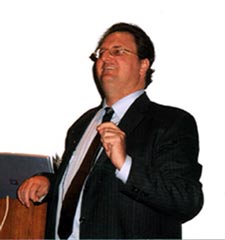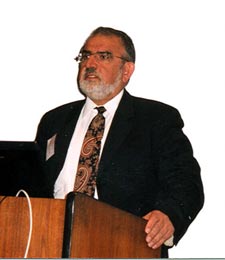IMSC holds annual Industry Day

Campbell Kennedy, Engineer, Pratt & Whitney

Jason Gregory, Senior Engineer, Electronic Arts

Alex Lightman, CEO, Charmed Technology

Prof. Iraj Ershaghi, Executive Director, USC Center for Interactive Smart Oilfield Technologies
IMSC's annual Industry Day in October featured talks by representatives from IMSC partner Pratt & Whitney, a major manufacturer of aircraft engines, and Electronic Arts, a prominent digital game manufacturer, among others.
Industry representatives also met with students to discuss career opportunities.
Campbell Kennedy, an engineer at Pratt & Whitney, described the development of a cutting-edge wireless Internet communications system for Korean Air that will feature IMSC technology. The system will dramatically cut costs and save time in aircraft engine maintenance.
Pratt & Whitney and Korean Air are calling on IMSC to integrate the Center's Remote Media Immersion (RMI) technology with a wireless component for the new system.
The project is being developed under the auspices of the Pratt & Whitney Institute for Collaborative Engineering (PWICE), established jointly at the University of Southern California and Inha University in Incheon, South Korea. Pratt & Whitney is Korean Air's main jet engine supplier.
With the system, Pratt & Whitney's engineers in the firm's East Hartford, CT, headquarters will enjoy unprecedented interaction with Korean Air mechanics working on the planes in Seoul, nearly 7,000 miles away.
In early October, IMSC key investigator Prof. Roger Zimmermann and his team demonstrated a live streaming linkup over the Internet of two-way high definition audio/video between IMSC and Inha University as part of the development of the system.
Kennedy also described other Pratt & Whitney projects, including one to track engine parts using radio frequency identification (RFID) tags.
Jason Gregory, senior engineer at Electronic Arts in Los Angeles, described his experience working on a new digital game, "Medal of Honor: Pacific Assault," which is about World War II battles in the Pacific. He said the growth of the game industry has led to the need for large teams of engineers, marketers and others, instead of the small groups who developed the early games. He said new digital technology is opening up new avenues for games in visualization and other areas.
Gregory said IMSC's Software Architecture for Immersipresence (SAI) might be useful in a game development environment. For more information on SAI, go to http://imsc.usc.edu/research/project/sai/index.html.
He also pointed out that IMSC's research in developing lifelike virtual humans could be important for characters in games.
Alex Lightman, the Chief Executive Officer of Charmed Technology, which makes wearable computers, said students should build credibility when they pursue business opportunities and pointed out he gained credibility when he wrote a book. He said that visualization centers using the latest streaming and multimedia technologies will be important in the future, and described how they will be useful in the oil industry, among others.
Lightman, who is also the founding CEO and Chairman of IPv6 Summit, Inc., said a meeting on IPv6 is scheduled for December 7-10, 2004, at the Hyatt Regency in Reston, VA. IPv6 (Internet Protocol Version 6) is a protocol designed by the Internet Engineering Task Force (IETF) to replace the current version, Internet Protocol Version 4. For more information on the IPv6 meeting, go to http://www.usipv6.com.
Prof. Iraj Ershaghi, Executive Director of the USC Center for Interactive Smart Oilfield Technologies (CiSoft), told how new multimedia technologies are being developed by the Center to assist in managing oil and gas fields. CiSoft was established by ChevronTexaco and USC.
Three USC Viterbi School of Engineering organizations are working on the project-IMSC, the Information Sciences Institute, and the Petroleum Engineering Department.
The project is focusing on the integration of field automation, reservoir simulation technologies, new and emerging well technologies, and real-time reservoir management in order to help reduce field development costs, speed up the analysis of information, and enhance operational reliability.
Prof. Ershaghi, who is a professor of chemical engineering, said research is being conducted in such areas as immersive visualization, signal processing and signal transmission. He also said a key goal of CiSoft is to focus on education programs and that a Master's in smart oilfield technologies was started this fall in the Viterbi School.
For more information on IMSC's projects with Pratt & Whitney and ChevronTexaco, contact Dr. Isaac Maya, IMSC's Director of Industry and Technology Transfer Programs at (213) 740-2592; imaya@imsc.usc.edu.